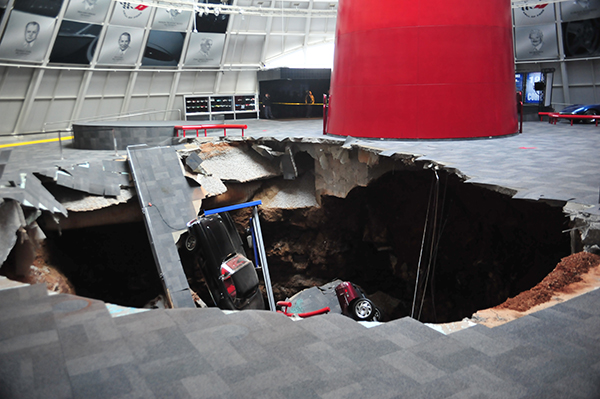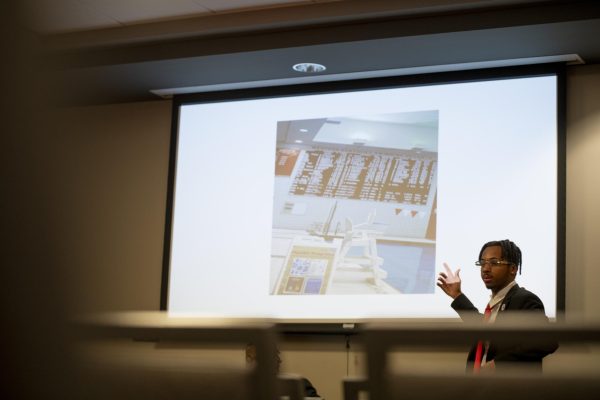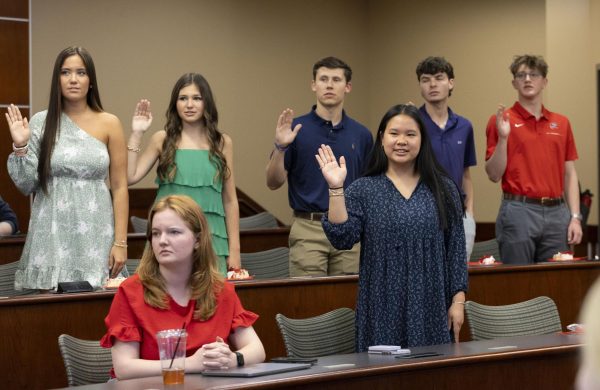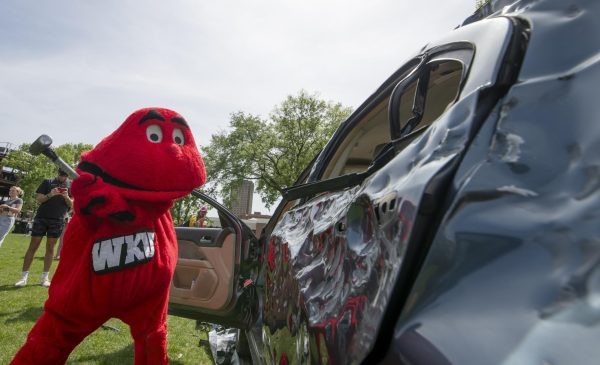Eight Corvettes lost in sinkhole
February 13, 2014
At 5:44 a.m. on Wednesday morning, officials from the National Corvette Museum received calls that a natural disaster had struck.
A sinkhole that measured 40 feet wide and 25-30 feet deep tore through the Skydome, swallowing eight of the museum’s prized automobiles. No one was injured during the collapse.
“I was just in there taking pictures yesterday,” Bob Bubnis, communications coordinator for the museum, said.
The Skydome, a large spiral dome connected to the central National Corvette Museum building by a hallway, housed roughly 70 to 80 Corvettes of varying model, size and color. Automobiles in this portion of the museum, as well as the rest of the museum, were either donated, on loan to or owned by the museum.
Officials safely removed all unaffected Corvettes from the dome.
“The 1983 was in there, which is the rarest ‘Vette there is,” Bubnis said. “But we managed to get it out, a number of pace cars and a few cars that had been on loan from some of our members.”
Two of the eight vehicles damaged in the sinkhole, a 1993 ZR-1 Spyder and 2009 ZR1 “Blue Devil,” were on loan from General Motors. The other six — a 1962 Black Corvette, a 1984 PPG Pace Car, the 1992 White 1 Millionth Corvette, a 1993 Ruby Red 40th Anniversary Corvette, a 2007 Mallett Hammer Z06 Corvette and the 2009 White 1.5 Millionth Corvette — were owned by the museum.
“It’s certainly a sad day here at the National Corvette Museum,” Wendell Strode, executive director of the museum, said. “Each of those cars had its own story.”
Strode said he has been unable to directly contact representatives from GM regarding the cars, but they should be easy to work with.
Strode also said he and other staff members are working on reaching out to owners of the vehicles in the dome to inform them of the safety and status of their cars.
“We’ve overcome adversity before, and we’ll certainly overcome this,” Strode said.
Structural and civil engineers from WKU were on site to assess the damage and stability of the sinkhole.
“They’re (sinkholes) very difficult to find during construction,” Matt Dettman, associate professor of civil engineering, said. “Now that it’s fallen out, we do see some continued instability in the wall that could possibly collapse more over time.”
Despite this, Dettman said he and his associates on sight declared the sinkhole relatively stable.
The museum released a video that showed a drone flying over and into the sinkhole to assess vehicles that had fallen. The black 1962 was standing upright, while others were barely visible under layers of dirt and debris.
The museum has yet to assess the costs of this disaster, as they still have to attempt to continue retrieving the fallen vehicles, review surveillance footage and meet with their insurers to get an estimate. A local contractor, Scott, Murphy and Daniel, will assist in recovery of this building and the damaged vehicles.
“There are at least two cars that, it appears to me, that could be saved recovered,” Strode said. “Certainly they’ve had some damage, so that decision will be a little bit later on.”
So far, no reconstruction time frame has been provided.
The museum closed for the day, turning away many who had traveled great distances to see the museum. Receptionists fielded calls from hopeful visitors throughout, though some were less than sympathetic about the day’s disaster.
Pam Pillow, a receptionist for the museum, had one caller in particular suggest all the damaged cars be replaced with Mustangs.
“You called the wrong place,” Pillow said.
This is not the first issue the city has had with sinkholes. In 2002, a sinkhole collapsed at Dishman Lane and Mill Valley Road that measured roughly 196 feet across and 22 feet deep at it’s deepest points. The damage done by the sinkhole cost $1 million to repair.
Sinkholes are the result of karst topography in and around Bowling Green. Karst is a chemical weathering process that involves the dissolution of rocks, particularly limestone.
Over periods of thousands of years, slightly acidic ground water — carbonic acid — dissolves subsurface limestone, creating large, underground caverns.
“Over time, as that infiltration of the groundwater carries over the soil, it ultimately becomes unstable and collapses,” Dettman said.
Dettman said the sinkhole at the Corvette Museum could have potential to expand, but is showing signs of migrating from the museum, not towards it.
“We might see a little more falling in over time, but right now it’s difficult to tell how much it’s going to collapse,” he said. “It appears to be migrating away from the building, not towards the main part.”
The museum will reopen today to the public. The Skydome, however, will remain closed until further notice. Damage is being assessed to determine what can be done to repair the building before the museum’s 20th Anniversary celebration. The celebration will be held Labor Day weekend.

























